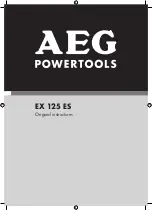
PROBLEMS
POSSIBLE CAUSES
REMEDIES
Tool runs at normal
speed but loses under
load
■.
Motor parts worn.
■
Cam clutch worn or sticking
due to lack of lubricant.
■
Lubricating clutch housing.
■
Check for excess clutch oil. Clutch cases
need only be half full. Overfilling
Can cause drag on high speed clutch parts,
i.e. a typical oiled/lubricated wrench requires
1
⁄2 ounce of oil.
GREASE LUBRICATED: NOTE:
Heat usually
indicates insufficient grease in chamber.
Severe operating conditions may require more
frequent lubrication.
Tool runs slowly. Air
flows slightly from
exhaust
■
Motor parts jammed with dirt
particles
■
Power regulator in closed
position
■
Air flow blocked by dirt.
■
Check air inlet filters for blockage.
■ Pour
air tool lubricating oil into air inlet as per
instructions.
■
Operate tool in short bursts quickly reversing
rotation back and forth where applicable.
■ Repeat
above as needed. If this fails return to
service centre.
Tools will not run. Air
flows freely from
exhaust
■
One or more motor vanes
stuck due to material build up.
■
Pour air tool lubricating tool into air inlet.
■
Operate tool in short bursts of forward and/or
reverse rotation where applicable.
■
Tap motor housing gently with plastic mallet.
■ Disconnect
supply. Free motor by rotating drive
shank manually where applicable
■
If tool remains jammed return to service
centre.
Tool will not shut off
■
‘O’ rings throttle valve
dislodged from seat inlet
valve.
■
Trigger valve curved or
blocked by dirt
■
Replace ‘O’ ring
■
Lubricate the trigger valve with special
lubrication. Or send the service center.
Motor will not run
■
The inside of Motor blocked
by dirt
■
Lubricate the motor and operate tool
■
Operate tool in short bursts of forward and/or
reverse rotation where applicable.
■
If tool remains jammed return to service
centre.
Sanding paper cannot
stick to the pad
■
Sanding pad damaged or
dirty
■
Replace the sanding pad
Note: Repairs should be carried out by a qualified person.

























